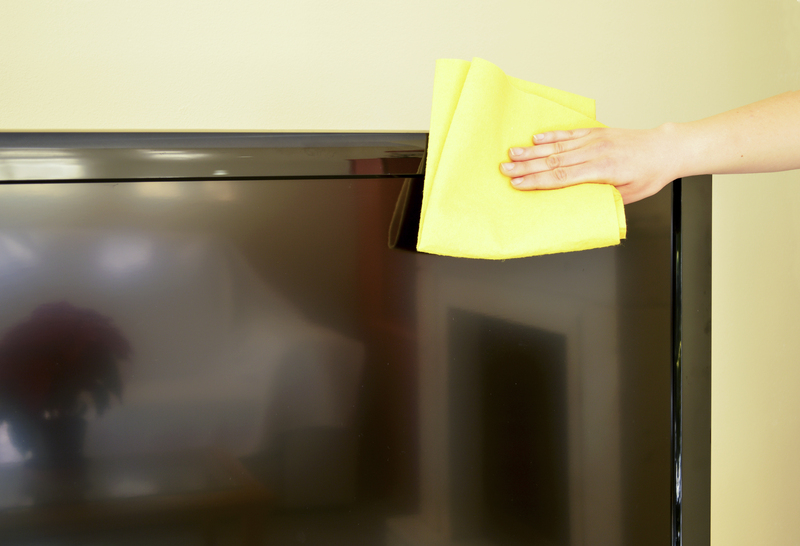Air Quality Essentials: Protecting Health in Residential and Business Settings
Posted on 22/09/2025
Air Quality Essentials: Protecting Health in Residential and Business Settings
Clean air is fundamental to a healthy life, whether you are at home, in the office, or running a business. With increasing awareness of indoor air pollution and its effects, understanding air quality essentials is more crucial than ever. This comprehensive guide explores techniques, tools, and practices for safeguarding air quality in both residential and commercial environments.

Why Air Quality Matters in Residential and Business Environments
Maintaining optimal air quality is not just a regulatory requirement for businesses but an essential component of wellness in all settings. Air contaminants can trigger a variety of health issues, from mild allergies to severe respiratory disorders. Ensuring clean and healthy indoor air protects building occupants, supports productivity, and enhances overall comfort.
Understanding Indoor Air Pollution: The Hidden Health Hazard
- Particulate Matter - Microscopic particles like dust, pollen, and pet dander can easily accumulate inside buildings, affecting respiratory health.
- Volatile Organic Compounds (VOCs) - Commonly found in paints, cleaning products, and office furniture, these chemicals contribute to poor air quality and may cause headaches and irritation.
- Biological Contaminants - Molds, bacteria, and viruses thrive in moist environments, elevating risk for infections and allergic reactions.
- Gaseous Pollutants - Carbon monoxide, radon, and nitrogen dioxide can build up indoors, sometimes reaching hazardous levels.
The Impact of Poor Air Quality on Health
Exposure to contaminated indoor air is increasingly linked to chronic health issues, especially among sensitive populations such as children, elderly, and those with existing respiratory conditions. Common symptoms of poor air quality include:
- Allergic reactions (sneezing, watery eyes, rashes)
- Headaches and fatigue
- Shortness of breath or worsened asthma
- Long-term respiratory diseases, including bronchitis and COPD
For businesses, compromised air quality can increase employee absenteeism, reduce efficiency, and potentially lead to liabilities.
Core Strategies to Improve Air Quality in Homes and Workplaces
Proactive management of indoor air quality involves understanding key contributors to pollutants and implementing targeted interventions to minimize exposure.
Ventilation: The Foundation of Healthy Air
Proper ventilation dilutes and removes pollutants from the indoors. Consider the following approaches:
- Natural Ventilation: Regularly open windows and doors to exchange stale air for fresh outdoor air.
- Mechanical Ventilation: Employ HVAC systems equipped with high-efficiency filters and regular maintenance schedules.
- Spot Ventilation: Use exhaust fans in kitchens and bathrooms to control localized moisture and pollutants.
Filtration and Air Purification Technologies
With advances in filtration, homeowners and businesses can now select from a range of air purifiers and filters:
- HEPA (High-Efficiency Particulate Air) Filters: Highly effective at capturing fine particles, allergens, and some bacteria.
- Activated Carbon Filters: Efficient at adsorbing gases, odors, and chemical fumes.
- UV-C Air Purifiers: Utilize ultraviolet light to neutralize airborne pathogens, boosting overall indoor air safety.
- Electrostatic Filters: Trap particles using electrostatic charge, often used in combination with other technologies.
Controlling Sources of Pollution
To significantly improve indoor air quality, identifying and mitigating pollutant sources is crucial:
- Limit Smoking Indoors: Designate outdoor smoking areas to avoid harmful tobacco smoke accumulation inside.
- Use Low-VOC Products: Opt for paints, cleaning agents, and office supplies that minimize chemical releases.
- Handle Moisture Smartly: Repair leaks, use dehumidifiers, and ensure proper drainage to prevent mold growth.
- Maintain Appliances: Service gas stoves, heaters, and HVAC systems regularly to prevent carbon monoxide leaks.
Monitoring Air Quality: Tools and Metrics
Modern technology offers accessible solutions to monitor indoor air quality in real time, providing actionable insights for homeowners and businesses.
Types of Air Quality Monitors
- Particle Sensors: Measure concentration of dust, pollen, and other airborne particulates.
- Gas Detectors: Track levels of hazardous gases, including CO2, carbon monoxide, and formaldehyde.
- Humidity and Temperature Sensors: Help control conditions that foster biological contaminants.
- Integrated Smart Devices: Connect with mobile apps to deliver instant feedback and maintenance recommendations.
Key Air Quality Metrics
- PM2.5 and PM10: Indicates concentration of fine and coarse particulate matter, linked to respiratory impacts.
- CO2 and CO: Carbon dioxide and monoxide measurements point to ventilation effectiveness and combustion safety.
- VOC Index: Reveals the level of chemical contaminants present in the indoor environment.
- Relative Humidity: Optimal levels (30-50%) reduce the risk of mold and dust mites.
Best Practices for Air Quality in Residential Settings
Maintaining healthy air at home requires a combination of strategies tailored to the household's size, location, and activities.
Routine Cleaning and Housekeeping
- Use HEPA Vacuums: Trap dust and allergens efficiently compared to standard vacuums.
- Regularly Wash Linens: Bedding, curtains, and rugs can harbor dust mites and other allergens.
- Declutter Living Areas: Minimizes surfaces where dust can settle.
Managing Humidity and Temperature
- Fix Leaks Promptly: Prevent mold-friendly environments in basements and bathrooms.
- Use Dehumidifiers: Especially in damp climates or during rainy seasons.
- Maintain HVAC Systems: Clean and replace filters every 2-3 months, especially during high-usage periods.
Safer Cooking and Emissions Control
- Install Range Hoods: Remove cooking fumes and humidity efficiently from kitchens.
- Avoid Burning Candles and Incense: These can release soot and VOCs indoors.
- Aerate After Renovations: New furniture, carpets, or paint jobs often emit higher levels of VOCs for weeks.
Business Air Quality: A Matter of Productivity and Compliance
Air quality in offices, industrial facilities, and commercial buildings is vital for staff health, regulatory compliance, and public trust.
Adhering to Occupational Air Quality Standards
- Follow OSHA Guidelines: The Occupational Safety and Health Administration provides standards for permissible exposure limits in American workplaces.
- Implement Air Quality Audits: Periodic professional assessments help identify risks and improvement opportunities.
- Train Staff: Educate employees about proper ventilation, cleaning protocols, and safe chemical use.
Optimizing Office and Industrial Air
- Upgrade to Smart HVAC Controls: Automated systems adjust ventilation based on occupancy and air quality sensors.
- Use Air Purification in Meeting Rooms: These high-traffic zones are hotspots for carbon dioxide and pathogens.
- Integrate Plants Carefully: Air-purifying plants may help manage low-level VOCs but monitor for humidity issues and allergies.
- Establish "No-Idling" Policies: For facilities with loading docks, reduce vehicle exhaust near air intakes.
Special Air Quality Concerns: Allergens, Pathogens, and Chemical Hazards
Addressing Allergens
Homes and offices close to greenery may face seasonal pollen invasions. Install high-grade filters and encourage allergy awareness during peak times. Pet-friendly premises should enforce regular pet grooming and cleaning regimens.
Tackling Pathogenic Risks
During flu seasons or pandemics, integrate air purifiers with UV-C or HEPA filters. Maintain strict hygiene among building occupants and provide sanitization supplies at key locations.
Managing Chemical Hazards
For workplaces using solvents, paints, or industrial chemicals, designate and ventilate storage areas, mandate personal protective equipment, and monitor gas levels. Quick response protocols for chemical spills are essential.
Emerging Trends and Technologies in Air Quality Management
Smart and Automated Solutions
- Internet of Things (IoT) Air Quality Sensors: Real-time monitoring, automated alerts, and integration with building management systems are revolutionizing indoor environmental control.
- AI-Driven Predictive Maintenance: Predict when filters or components require servicing to maximize air system efficiency.
- Eco-Friendly Building Materials: Sustainable materials reduce off-gassing and promote healthier interiors.

Air Quality Policy and Community Initiatives
Local governments now offer incentives or regulations promoting better indoor air standards. Participation in air quality certification programs--such as WELL or LEED--demonstrates commitment to occupant wellness and environmental responsibility.
Community Action and Public Health Campaigns
- Awareness Events: Organize "Air Quality Days" at schools or offices to promote best practices.
- Transparency: Businesses can display real-time air quality index in lobbies to show ongoing commitment to safety.
- Partnerships: Collaborate with environmental groups to address broader urban or regional air challenges.
Conclusion: Breathe Easier--Prioritize Air Quality Protection
Clean air is not an option but a necessity. Whether at home or in the workplace, safeguarding indoor air quality ensures improved health, enhanced productivity, and peace of mind. With informed choices, smart investments in technology, and responsible daily habits, everyone can play a role in reducing exposure to harmful pollutants.
By staying vigilant, utilizing modern air quality solutions, and embracing proactive policies, both homeowners and business leaders can foster environments that truly support the wellbeing of all occupants. Remember: Every breath matters. Invest in your air, and you invest in your future.




